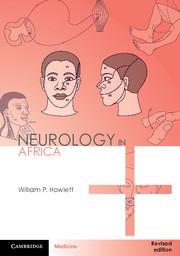Book contents
- Frontmatter
- Dedication
- Contents
- PREFACE
- Acknowledgments
- Part II Neurological Disorders
- 3 Public Health
- 4 Epilepsy
- 5 Stroke
- 6 Neurological Infections
- 7 Protozoal Andhelminthic Infections
- 8 Neurological Illness in HIV Disease
- 9 Coma and Transient Loss of Consciousness
- 10 Paraplegia Non Traumatic
- 11 Disorders of Peripheral Nerves
- 12 Cranial Nerve Disorders
- 13 Myopathies and Myasthenia Gravis
- 14 Movement Disorders and Motor Neurone Disease
- 15 Headache and Facial Pain
- 16 Intracranial Tumours
- 17 Dementia
- 18 Inherited Neurological Disorders
- 19 Head and Spinal Injury
- 20 Care in Neurology
- INDEX
- ABBREVIATIONS
- USEFUL WEBSITES
12 - Cranial Nerve Disorders
from Part II - Neurological Disorders
- Frontmatter
- Dedication
- Contents
- PREFACE
- Acknowledgments
- Part II Neurological Disorders
- 3 Public Health
- 4 Epilepsy
- 5 Stroke
- 6 Neurological Infections
- 7 Protozoal Andhelminthic Infections
- 8 Neurological Illness in HIV Disease
- 9 Coma and Transient Loss of Consciousness
- 10 Paraplegia Non Traumatic
- 11 Disorders of Peripheral Nerves
- 12 Cranial Nerve Disorders
- 13 Myopathies and Myasthenia Gravis
- 14 Movement Disorders and Motor Neurone Disease
- 15 Headache and Facial Pain
- 16 Intracranial Tumours
- 17 Dementia
- 18 Inherited Neurological Disorders
- 19 Head and Spinal Injury
- 20 Care in Neurology
- INDEX
- ABBREVIATIONS
- USEFUL WEBSITES
Summary
Cranial nerve disorders are common neurological disorders. The clinical skills needed to examine the individual cranial nerves are presented in chapter 1.The overall aim of this chapter is to present the main cranial nerve disorders and to integrate examination and localization in their diagnosis. After reading the chapter the student should be able to localize and diagnose main disorders affecting pupils, vision, eye movements, facial sensation and movements, hearing, speech and swallowing.
OLFACTORY NERVE
Smell
Neurological disorders involving the olfactory nerve are uncommon and the olfactory nerve is rarely tested in day to day clinical practice. During a routine neurological examination it is sufficient to ask the patient if there is a loss or decrease in the sense of smell (anosmia). Frequently patients are unaware of a loss of smell or may only complain of losing their sense of taste. This is because both smell and taste are used together to appreciate the flavors of food and drink. If there is a loss or deterioration in smell, then each nostril should be tested separately as outlined in chapter 1. The most common cause of transient loss of smell is mucosal swelling in the nose or sinuses as a result of local infection e.g. head cold, allergy or smoking. Anosmia may occur after a head injury when there is a shearing injury to the olfactory bulb and its central connections through the cribriform plate. A rare cause of unilateral anosmia is a meningioma in the olfactory groove. Olfactory hallucinations are a feature of temporal lobe epilepsy.
Optic nerve
Disorders affecting the optic nerve are common and clinical assessment involves a history and examination. The history involves asking about a loss or decrease in vision, double vision, pain and headache and their mode of onset, progression and time course. The examination of the optic nerve includes testing the pupillary responses, visual acuity, visual fields and fundoscopy. Details concerning the technique of examination have already been set out in chapter 1.
PUPILLARY RESPONSES
Pupillary size and reactions
Both pupils should be normal in size (2–6 mm), equal, central and circular (ECC). The iris controls the size of the pupil
- Type
- Chapter
- Information
- Neurology in AfricaClinical Skills and Neurological Disorders, pp. 285 - 308Publisher: Cambridge University PressPrint publication year: 2015



